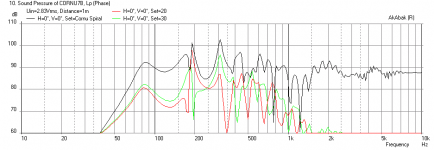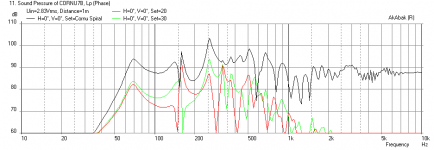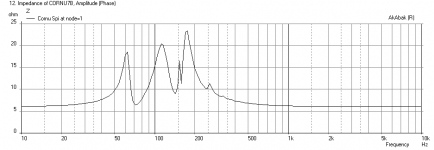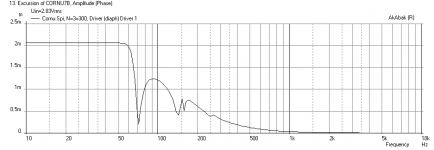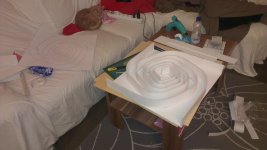Coen, it would be nice if you could make and post photos of work-in-progress of this one.
Me, I don't need another set of speakers at this time, (no space) but this one may be hard to ignore. I was just staring at a blank wall in my bedroom and thought "why not...." 🙂
Hi Vix, ofcourse i'll post some work in progress pics.. i just hope glueing this thing won't get to messy 🙂
Sim of Cornu with FE85
Coen,
Here are sims of the Cornu with the driver you have chosen. It can work reasonably well in a Cornu ranging from 20 in to 24 in x 2.5 in deep. The bigger, the deeper the bass. I would go with the biggest you can. The 24 in will reach down to 60 Hz.
Regards,
X
20 in x 2.5 in deep:
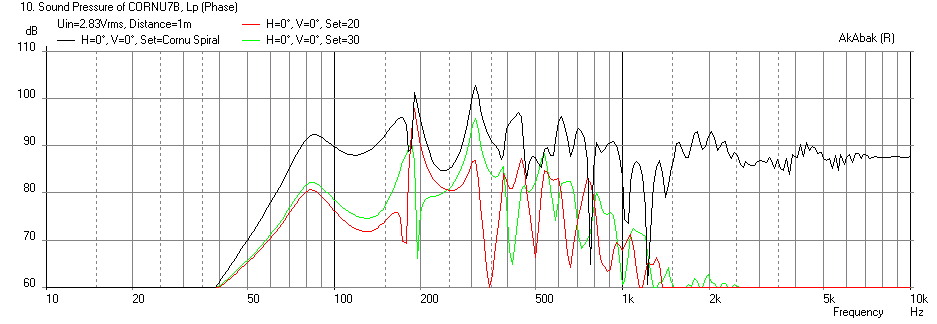
22 in x 2.5 in deep:
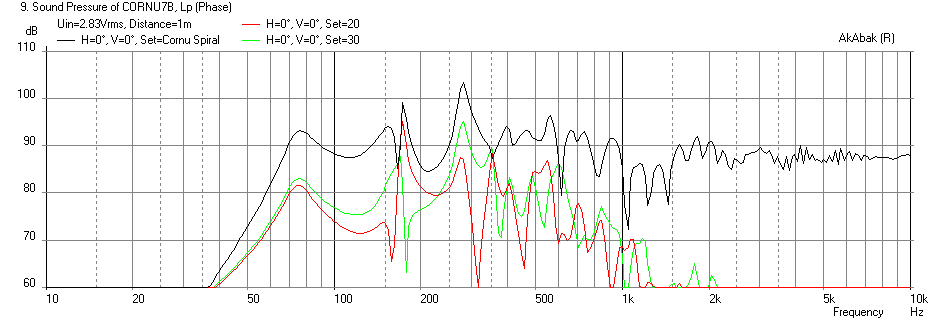
24 in x 2.5 in deep:
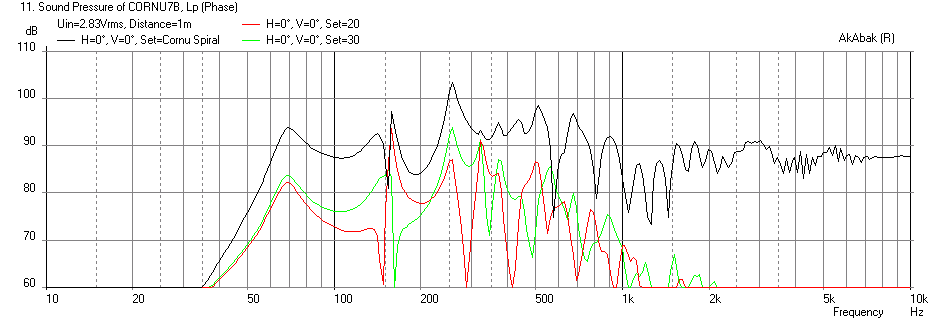
Impedance of 24 in:
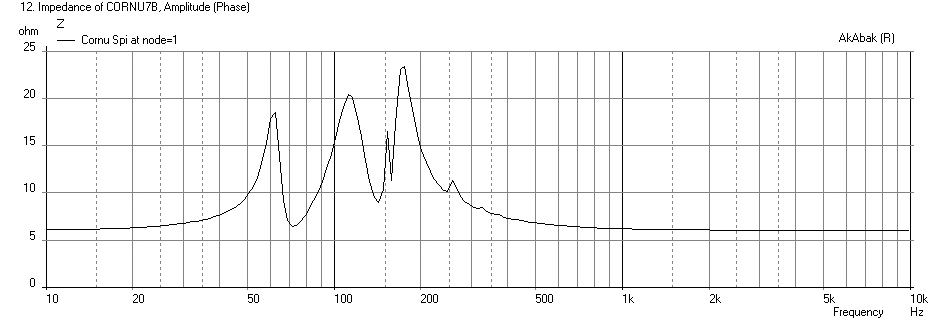
Cone Excursion of 24 in:
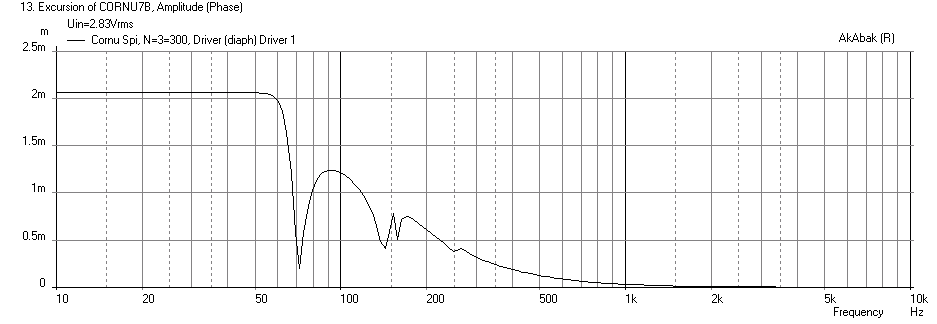
Good luck with your build! It will sound great. 🙂
I've decided to go with the Fountek FE85
Coen,
Here are sims of the Cornu with the driver you have chosen. It can work reasonably well in a Cornu ranging from 20 in to 24 in x 2.5 in deep. The bigger, the deeper the bass. I would go with the biggest you can. The 24 in will reach down to 60 Hz.
Regards,
X
20 in x 2.5 in deep:

22 in x 2.5 in deep:

24 in x 2.5 in deep:

Impedance of 24 in:

Cone Excursion of 24 in:

Good luck with your build! It will sound great. 🙂
Attachments
Hi X,
Thanks for the simulation! i was planning on doing a full foam speaker but the boards are only 50cmx70cm, to get 24 inches i'd need to paste them together or use multiplex / mdf for the back and front.
Btw what sort of glue is everyone using for full foam or foam/wood? should i think of buying a glue gun or just get something like gorilla glue?
Thanks for the simulation! i was planning on doing a full foam speaker but the boards are only 50cmx70cm, to get 24 inches i'd need to paste them together or use multiplex / mdf for the back and front.
Btw what sort of glue is everyone using for full foam or foam/wood? should i think of buying a glue gun or just get something like gorilla glue?
Use a half sheet of ply and make the box 23.75"
Use hot glue for gluing the first side and plain white or yellow glue for the second.
Use hot glue for gluing the first side and plain white or yellow glue for the second.
A while ago I built a pair of 22" spirals with TB W4 bamboo drivers for a friend. Well I got to sit and listen to them properly set up in his house today. We were both blown away by the sound after listening to some Bill Evans, Chick Corea, Sarah Brightman and a couple Shostakovich string quartets. These speakers sounded great with everything we played. 😀😀😀
cheers
cheers
Prezden,
Did you feel that there was a missing frequency patch or did it pretty much sound whole? 22 in should get you down to about 60 Hz I think. I think you must have more Cornu builds than anyone here. How many so far ?
Did you feel that there was a missing frequency patch or did it pretty much sound whole? 22 in should get you down to about 60 Hz I think. I think you must have more Cornu builds than anyone here. How many so far ?
I noticed that the path length down one side of the split is different from the other side, maybe about 15%. How does this affect the output, in comparison to a single path (no split) with the same overall cross-section area?
This is my first horn encounter, just trying to understand how this stuff works. 😱
🙂
This is my first horn encounter, just trying to understand how this stuff works. 😱
🙂
Not sure but it's not that difficult to have made them all the same so Daniel must have discovered an advantage in doing it that way.
I noticed that the path length down one side of the split is different from the other side, maybe about 15%. How does this affect the output, in comparison to a single path (no split) with the same overall cross-section area?
This is my first horn encounter, just trying to understand how this stuff works. 😱
🙂
It helps to provide a smoother frequency response. Look at the results of the simulation from the earlier post:

The red (shorter path exits to the left on the bottom) and green (longer path exits down on the right) line represent the output from the two different length horns (just 2 of 4). If you had just one length, it would be double the amplitude of the green without the red to balance it.
Of course, this can be taken to an extreme as in the case of my Panpipe BLH (5 unequal length horns): http://www.diyaudio.com/forums/full-range/236779-panpipe-pentahorn-blh-speaker.html
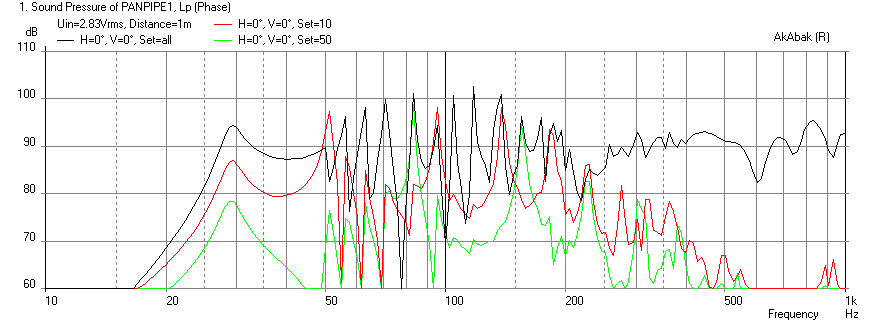
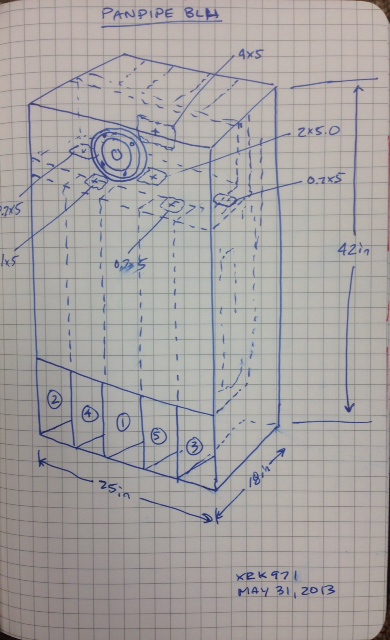
So far, no one has been crazy enough to make this to see if my simulations pan out 😀
Last edited:
Hi X
When my friend and I were listening we both felt that they were possibly the best speakers we have heard. Now neither one of us is what I would call an audiofile but we have both listened to a lot of music for a long time. They are just really good sounding speakers 😀
Thanks to you, Cal and others for making it possible to build them. These are the 4th pair I have made; all in different sizes and I think they all sound great.
When my friend and I were listening we both felt that they were possibly the best speakers we have heard. Now neither one of us is what I would call an audiofile but we have both listened to a lot of music for a long time. They are just really good sounding speakers 😀
Thanks to you, Cal and others for making it possible to build them. These are the 4th pair I have made; all in different sizes and I think they all sound great.
Cool 😀we both felt that they were possibly the best speakers we have heard
It helps to provide a smoother frequency response.
If you had just one length, it would be double the amplitude of the green without the red to balance it.
Thanks. The pictures and those comments help.
🙂
Coen,
Very nice work, looks great. Nice kitty you have there.
Looking forward to first sound.
Very nice work, looks great. Nice kitty you have there.
Looking forward to first sound.
Now if you could only sleep in your own bed. That couch looks nice, kitty included, but...i'm well on my way making my first speaker. 🙂
Hey I've been there. My honey now accepts my hobby. 🙂
Now if you could only sleep in your own bed. That couch looks nice, kitty included, but...
Hey I've been there. My honey now accepts my hobby. 🙂
That's my lovely assistant who's fallen asleep on the couch.. she was actually quite usefull in holding down the foamboard strips waiting for the glue to dry, but it did get a little late.. (2am)
Waiting for the front part to dry now and thinking about how to attach it to the wall 🙂
Coen,
Very nice work, looks great. Nice kitty you have there.
Looking forward to first sound.
Thanks, it turned out pretty good, first time i used a glue gun.
One thing I wonder about on a practical vs theory level is why a bunch of small mouths apparently end up acting like one big mouth? Since the low freq. cut off of a horn is supposed to depend in large part on the circumference of the mouth, one theoretical guess might be that you would have a bunch of trumpets sounding, instead of a tuba.
I can imagine how a wavefront could be divided up and then recombine at multiple mouths. But then also if there are different path lengths, then what is recombining and how and when? Maybe the spikes in the FR graphs partly show constructive and destructive interactions outside the horn mouths.
Maybe the small cornu horn segments are more resonant-like a TL-than a horn? What is the average the path length on a 24" cornu? Something like 20"?
The wall would extend the horn, sure, but Cal's cornus made good sounding 60hz or so bass in "free air" outside at DIYFEST.
Of course all practical size horns for the home are not big enough to act like an ideal horn in the lower bass range, and so are so compromise between a horn and a pipe utilizing standing waves.
I can imagine how a wavefront could be divided up and then recombine at multiple mouths. But then also if there are different path lengths, then what is recombining and how and when? Maybe the spikes in the FR graphs partly show constructive and destructive interactions outside the horn mouths.
Maybe the small cornu horn segments are more resonant-like a TL-than a horn? What is the average the path length on a 24" cornu? Something like 20"?
The wall would extend the horn, sure, but Cal's cornus made good sounding 60hz or so bass in "free air" outside at DIYFEST.
Of course all practical size horns for the home are not big enough to act like an ideal horn in the lower bass range, and so are so compromise between a horn and a pipe utilizing standing waves.
New idea alert!
(please note that this idea came to me in the middle of 2 day marathon to write a 50-page financial report... not the best of situations)
How about a BVR type cornu?
A BVR is like a horn loaded bass reflex box, and according to Scottmoose and David from planet10 (who coined the term BVR for Big Vented Reflex) is very good at accommodating different drivers with somewhat differing T/S parameters but similar Sd's.
IIRC it works so well because it seems to influence the T/S params of the drivers to the extent of minimizing their influence on the enclosure's behaviour (remember 50-page report, not the sharpest writing right now).
In practice this would mean a bigger chamber volume and a much shorter horn.
Comments?
(please note that this idea came to me in the middle of 2 day marathon to write a 50-page financial report... not the best of situations)
How about a BVR type cornu?
A BVR is like a horn loaded bass reflex box, and according to Scottmoose and David from planet10 (who coined the term BVR for Big Vented Reflex) is very good at accommodating different drivers with somewhat differing T/S parameters but similar Sd's.
IIRC it works so well because it seems to influence the T/S params of the drivers to the extent of minimizing their influence on the enclosure's behaviour (remember 50-page report, not the sharpest writing right now).
In practice this would mean a bigger chamber volume and a much shorter horn.
Comments?
Howard,
The 24 in Cornu has an unfolded longest horn path of 1.44m IIRC. That is consistent with 60 Hz 1/4-wave freq. The size of the mouth as a radiator is taken into account by the AkAbak sims so the influence of mouth size is in there. As BLH's go, the Cornu is one of the few with an expansion ratio >> 10. It is 25 in fact and this accounts for its ability to get +10dB to +12 dB gain in the bass region without taking up a huge amount of room on the floor.
The 24 in Cornu has an unfolded longest horn path of 1.44m IIRC. That is consistent with 60 Hz 1/4-wave freq. The size of the mouth as a radiator is taken into account by the AkAbak sims so the influence of mouth size is in there. As BLH's go, the Cornu is one of the few with an expansion ratio >> 10. It is 25 in fact and this accounts for its ability to get +10dB to +12 dB gain in the bass region without taking up a huge amount of room on the floor.
- Home
- Loudspeakers
- Full Range
- Ever think of building a Cornu Spiral horn? Now you can!
